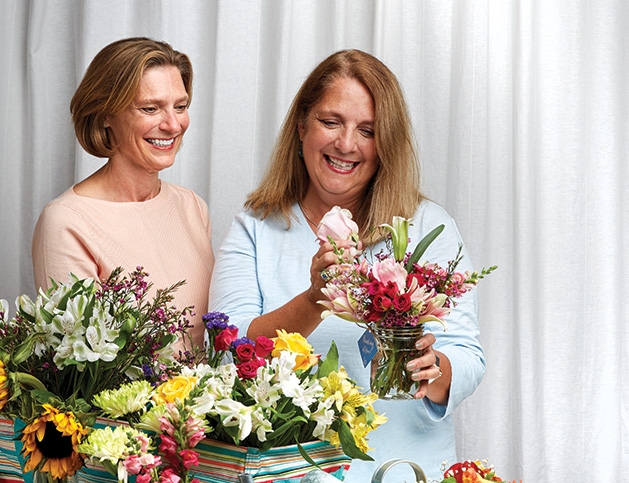
Bluebirds & Blooms is a nonprofit organization that, for the past year and a half, has worked to show those afflicted with memory loss that they have not been forgotten. The organization works closely with a team of volunteers who gather flowers from events to create bouquets gifted to those residing in assisted living.
The organization began after co-founder Karen Wooldridge experienced the declining health of a family member who lived in memory care.
“My father passed away six years ago from Alzheimer’s, so I really have a heart for people with memory loss,” Wooldridge says.
Wooldridge worked with Laura Hogan at Gentle Transitions. Hogan had heard of an Idaho gardener for a hospice center who brought flowers to a woman she’d seen through the window and pondered the concept of Bluebirds and Blooms for a few years. She’d noticed that memory care residents who enjoy visitors didn’t always receive them.
So how exactly does the group reuse flowers? Through a process called “deconstruction,” Wooldridge explains that donated flowers are sorted through to discard those that are spent and set aside those still in bloom. The salvaged flowers are then sorted into buckets according to color and type. From there, volunteers put together eye-catching bouquets that promise to brighten a room and put a smile on a recipient’s face.
Hogan says of the organization’s name, “Our mission is to bring happiness … so we just kept coming back to bluebirds being a symbol of happiness.” She notes that she and Wooldridge met when they were “bluebirds” together as young girls.
“The flowers are kind of like a gateway. We knock on their door, tell them we’ve brought some flowers and they just light up ... They love visitors, and they love the bouquets,” Wooldridge says. “Sometimes the flowers even bring back memories for some of them ... many remember that they had gardens or things like that. It’s a very special thing to see what a simple bouquet of flowers can do.”
People who wish to help can either volunteer their time putting together bouquets and making deliveries, or they donate their bouquets that would otherwise be discarded to be reused. “Every arrangement is unique because we have no idea what [flowers] we’re going to receive on any given day,” Wooldridge says. “The happiest people who donate are the those who have a personal connection to the disease, or to the flowers. Brides and grooms appreciate having a meaningful thing happen to their wedding flowers, as do people from memorial services. They love seeing their flowers go to a good cause.”
Hogan says, “My favorite part is actually my relationships with the volunteers, the communities and caregivers we work with to deliver flowers to residents with memory loss.”
Wooldridge says, “I recently watched a documentary about people with dementia, and the focus was on what people can still do rather than what they can’t. That made me feel reinforcement for what we are doing. We’re entering these people’s lives to remind them they are important and valuable.”
Bluebirds & Blooms will continue to expand its reach to help as many memory loss patients as possible to reclaim a bit of joy.
“The reception we have received has made it clear that we are exactly where we are meant to be,” Wooldridge says. “And it’s all because of a simple bouquet of flowers.”
Bluebirds & Blooms
Facebook: Bluebirds & Blooms
Instagram: @bluebirds_and_blooms









